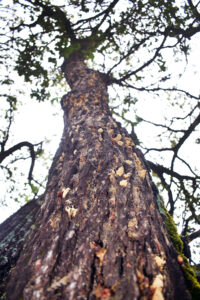
Wisconsin DNR invasive forest insects program coordinator Andrea Diss-Torrance demonstrates scraping a spongy moth egg mass off a tree while making a video on the subject for the DNR. / Photo Credit: Wisconsin DNR
By Art Kabelowsky, DNR Forestry Outreach/Communications Specialist
Arthur.Kabelowsky@wisconsin.gov or 608-335-0167
The fall and winter months present a perfect opportunity to protect trees by searching out and removing spongy moth egg masses.
The invasive insects currently exist only as tiny eggs, camped out in egg masses that can be found in places such as tree trunks and branches, under park picnic benches and swing sets, and under the awnings of buildings.
And now, the Wisconsin Department of Natural Resources (DNR) has debuted a short video showing exactly how to easily and safely remove egg masses to reduce next spring’s population of hungry spongy moth caterpillars.

A tree at Glen Oak Hills Park in Madison is covered with spongy moth egg masses. / Photo Credit: Wisconsin DNR
Anyone armed with a plastic knife, a jar of soapy water and a little determination can find and remove the egg masses — which are tan-colored, about the size of a quarter, and can hold 300 or more eggs each.
Wisconsin’s trees would appreciate the help. During a spongy moth outbreak in the summer of 2023, Wisconsin forests experienced a record-breaking amount of defoliated acreage.
Andrea Diss-Torrance, the invasive forest insects program coordinator for the DNR’s Forest Health team, demonstrated the egg mass removal technique and narrated the video, which was shot and edited in-house.
The video follows one launched last spring on using a burlap band to trap spongy moth caterpillars on tree trunks.
